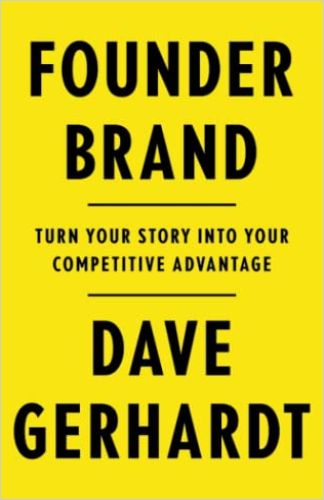Marketer Dave Gerhardt explains how and why you should make a company’s founder into an effective personal brand.

Continuous Feedback Loop
Dave Gerhardt, founder of the marketing consultancy DGMG, offers a framework for creating a “founder brand” based on the life and personality of your company’s founder. A founder brand provides an ongoing connection with potential and current customers as well as continuous public feedback that enables the company and its marketers to shape future decisions without spending on polling or advertising.
A Focused Market
Developing a founder brand fulfills marketing’s goal to build “awareness, trust and credibility.” Focusing on your firm’s founder provides a personal connection who establishes trust with customers and connects them to a human being, not a logo.
Building a brand for the founder is an incredible way to…build trust and credibility with potential customers in the early days.Dave Gerhardt
While working for Draft, a conversation focused marketing company, Gerhardt created a brand for David Cancel, a Drift founder.
A master at writing clever tweets, Cancel already had 40,000 Twitter followers. Gerhardt leveraged those followers to create an audience for Cancel’s new podcast, Seeking Wisdom. When the podcast launched, listeners downloaded it 50,000 times per month. Gerhardt booked Cancel for events and interviews on other podcasts. He also launched Drift’s annual “Hypergrowth” event. Within two years, Drift’s revenue exceeded $30 million.
Gerhardt duplicated that strategy at Privy for its founder Ben Jabbawy. Privy, which helps marketers quickly develop customer relations, was later sold in a “nine-figure deal.”
A founder with a brand gives your marketing efforts superpowers. Dave Gerhardt
Gerhardt explains that to create a founder brand, you must tell your founder’s story, create content, publish and master the feedback loop.
Stories
To create your founder’s story, look for ways that your founder’s background relates to the company or its product. What problem does the company or the product solve? What problem or “villain” thwarts your customers? What is your solution? Can you explain what happens in a consumer’s life “before and after” having your product?
The more transparent, open and potentially emotionally vulnerable you are in your story, the easier it is for your niche to feel a connection.Dave Gerhardt
To establish your brand, initially, with a small customer base, Gerhardt advises targeting a specific group of potential customers and marketing your founder brand directly to it.
He created a targeted newsletter and curated weekly links. Although he followed product marketing leaders on social media, he didn’t offer them a sales pitch. As his email list grew, product marketers submitted articles to his newsletter. Subsequently, Gerhardt turned the newsletter into a blog.
Find a Problem to Solve
Drift’s product marketers hated the lead forms their customers had to fill out, but its own website featured just such an onerous form. Drift turned getting rid of its lead form into a problem-solving case history. It offered articles, videos and podcasts showing how it solved the lead form issue, and it created a “No Forms” movement. This led to a book.
We turned what could have been a credibility disaster into one of our best marketing channels.Dave Gerhardt
To determine your niche, define the ideal customer for your existing product – not a future idea of your product, but what you provide right now. Identify a common problem that it solves, offer your solution and end your offer with the name of your product. Use this problem-solving setup for all your marketing.
Social Media
To become a social media presence, a founder must post short messages on Twitter and longer items on LinkedIn at least three times a week. Then the founder can create a podcast for a target market and embark on public speaking.
Use a clear headshot and a professional background banner for your social media profile. Change the banner to promote upcoming events or new products. While Twitter and LinkedIn allow you to create a bio, LinkedIn gives you more space. Update your bio regularly. On Twitter, focus on your niche area.
On both sites, share things other people post that your target audience will find helpful. For example, the Chief Digital Evangelist at Salesforce has more than 500,000 followers, built largely from curating content dealing with “marketing, leadership and technology.”
Sharing “your reality” with online followers builds credibility and trust. Include personal stories.
Content
To start a niche podcast, determine your expertise; research similar podcasts and identify a gap you can claim as your own. Differentiate your podcast by showcasing your knowledge and personality. Listeners come for content, but they stay and become loyal when they feel a personal connection with the host.
Plan the format, length and frequency of your podcast. Before your initial broadcast, prepare a backlog of prerecorded episodes.
After social media, a podcast is the single best channel to build a brand as a founder today.Dave Gerhardt
Use a hosting site such as Transistor.fm to publish your podcast. Prior to a podcast’s release, highlight your upcoming guests and content on social media. After recording an episode, go back on social media to recap what happened and state when the podcast will be available. If you videotaped an interview, put a clip or photo online.
Maximize Podcast Content
You want to use your founder’s podcast to generate traffic to your blog or corporate website. You can also use the podcast as material for ghostwriting a book, magazine articles or other material.
Offer perks for podcast subscribers. For example, successful entrepreneur Tim Ferriss urges listeners to subscribe to his website, which gives them his “5-bullet Friday” information each week.
Stick with your podcast for at least 12 months. Build your community by creating a Facebook group. And for the first two years, accept all speaking opportunities.
A Continuous Loop
Online followers serve as a marketing anchor.
The combination of social media and podcasting can transform you from a founder to a mini media company.Dave Gerhardt
Keep track of anything you do outside your podcast, such as hosting a dinner for customers, and use it as content for the podcast. Integrating that content into social media, blogs, books, articles and speeches provides a continuous loop for outreach and improvement.
Beginners Overview
Dave Gerhardt switches, with unrelenting enthusiasm, between occasional original actionable insights and surprisingly basic information about social media and podcasts. Providing elementary information may work against Gerhardt positioning himself as an expert, but his book will be a boon to beginners – if less necessary, but still useful, to those who are fluent with the web, social media and its manifestations. Gerhardt succeeds in presenting and selling his overall strategy, which is clever and useful, and in providing general tactics and direction. You can turn to his manual for encouragement and solid direction, even if you may need more details for implementing his strategy.
Dave Gerhardt and David Cancel co-wrote Conversational Marketing: How the World’s Fastest Growing Companies Use Chatbots to Generate Leads 24/7/365 (and How You Can Too).
Other helpful books on brand marketing include Building a StoryBrand: Clarify Your Message So Customers Will Listen by Donald Miller; Brand Identity Breakthrough: How to Craft Your Company’s Unique Story to Make Your Products Irresistible by Gregory V. Diehl; and Designing Brand Identity: An Essential Guide for the Whole Branding Team by Alina Wheeler.






